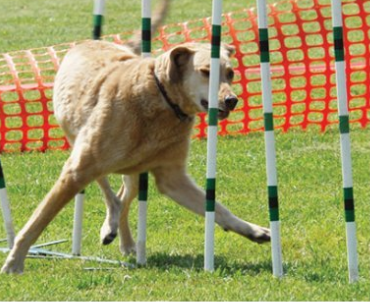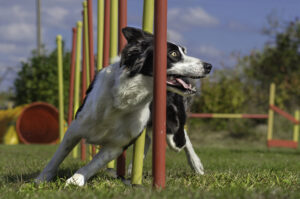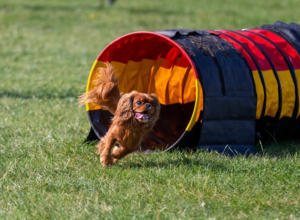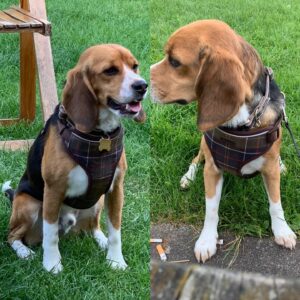As mentioned in a previous blog, sport dogs can get a variety of injuries, such as:
Agility – shoulder muscular injuries such as biceps brachii tenosynovitis, medial shoulder instability, and carpal injuries (Baltzer, 2012), and iliopsoas muscle strain (Markley et al. 2021)
Flyball – chronic ligament laxity and achilles/calcaneal tendon rupture (Baltzer, 2012)
Racing Greyhounds – general muscle tears alongside metacarpal and metatarsal fractures (Knight, 2018)
Gundog and Canicross dogs tend to receive injuries as associated with the breed as-well-as general abrasion and foot injuries. (See “Your Dog Breed – What Can Go Wrong?”
Appropriate warm-ups for the sport being undertaken, have been found to help prevent injuries and improve performance in humans (Woods et al. 2007) and horses (McGowan et al., 2015; Tranquille et al. 2020), so why don’t we really talk about it in dogs?!
This blog is going to focus more on agility, as that is the more common of the dog sports and the one I deal with the most, but if you need help transferring any of this information to a different sport you do with your dog, get in touch! It is also highly advised a sporting dog receives a physiotherapy assessment at least every few months to ensure they are still fit for the task and there are no signs of underlying injury.
Physiological/Musculoskeletal Requirements of Sporting Dogs
Agility comes with extreme acceleration, speed, and torsion, which can put strain on joints, tendons, ligaments muscles, you name it! The higher the level, generally the greater the risk due to the greater intensity of obstacles and increased speed. Speed makes everything more complex! It increases forces of all the other elements and has been shown to increase risk of injury, with starting jumping and weave obstacles later than 18months reducing risk of injury (Markley et al. 2022). However this isn’t always the case, as at lower level you can have injuries occur due to dogs that are not correctly conditioned, or are not suitably designed for the sport (such as too heavy/overweight, too young/old, poor conformation, etc).
Jumping
Jump height increasing with advancing levels may also play a role in increased injury risk, as the vertical force up the limb is highest when dogs land at a more acute angle after completing a higher fence when compared with a lower jump taken at a higher speed. Peak vertical force was 4.5 times body weight in the forelimbs following a hurdle type obstacle. In addition, the forelimbs are loaded asymmetrically upon landing which can cause forces to be higher in one limb repetitively more often, leading to injury, especially of the shoulders (Pfau et al. 2011).
Due to dog height requirements for classes, those at the bottom of the height range for classes may suffer due to the size of fences compared to their body height. This has been shown to put huge strain on structures such as the scapulohumeral (shoulder) joint, radiohumeral (elbow), sacroiliac (sacrum (lower back) and pelvis) and hock (ankle) joints (Birch and Lesniak, 2012). Therefore putting these dogs at greater risk of shoulder injuries like biccipital (biceps brachii) tenosynovitis, or iliopsoas strain.

Twisting
Weave obstacles have limited research, but some research has found “front feet single stepping” (shown below) between the poles to be the fastest (Eicher et al. 2021), but this does not mean the most effective or the least risk…As shown below, the weave poles put significant torque through the body, it just has not been clarified through research, however it is quite clear from just looking at photos how each aspect of the body undergoes strain. The single foot placement example below may be quicker, but places extreme abduction forces through the shoulder, causing medial shoulder instability (Zink and Van Dyke, 2018).

If you look at the photo below, it may seem more balanced, but it is clear the neck turning left is putting strain down the outside (laterally) of the right forelimb shoulder, and the digging in to the ground to stabilise with the right digits is placing strain medially (inside). The left forelimb shoulder joint is under torsion at the scapula is in line with the ground/weave pole but below that the limb is moving medially and placing strain through the supraspinatus to do so. Although we cannot see the back it will be have to twist through, putting unequal strain either side, with the left hindlimb creating all the pushing power alone before entering extension and torsion through the stifle (as the right hindlimb is about to do to twist round the pole, putting strain through the iliopsoas muscle. There is a reason this is a higher level agility obstacle! Additionally, as mentioned earlier, research notes starting weaves prior to 18months increases risk of injury due to vital structures not yet being mature prior to adding extreme torsion (Markley et al. 2022).

Obstacles
Obstacles such as A frames start at more advanced training heading to competition, which also usually means the dogs are older, which can pose an injury risk in itself. Variations in A frame height impact carpal (wrist) extension, resulting in the dog reaching end carpal extension repetitively. Therefore with time, the soft tissues affording support for the joint can succumb to injury (Appelgrein et al. 2018). Additionally the A frame has been shown to utilise greater joint range of motion and distal (lower) limb torsion, particularly when landing, than of jumping obstacles (Blake and Ferro de Godoy, 2021).
There is not research on every obstacle, hopefully this improves, so for now we have to theorise, and if an obstacle like an A frame that does not move can encounter injuries, it stands to reason obstacles like the see-saw, with the added concussion-al element of it moving, is also taxing on the body. It is also important to note that just because they don’t leave the floor, doesn’t mean it isn’t taxing on the body…

Exercises to Strengthen
Based on these requirements, we want to strengthen the structures involved to prevent injury! Therefore in horses (another quadruped), it has been noted the importance of cross training (doing other exercise besides the sport), and ensuring they are fit for purpose; so it stands to reason we should be doing the same with our sporting dogs, and not just expecting our once a week agility to be enough conditioning.
Slow lead walking – so the walk is a 4 beat gait with no suspension phase. That means your horse and dog have to use concentric (shortening) and eccentric (lengthening) muscle contractions for every stride to produce movement, and isometric (contractions without a change in muscle length such as core muscles). Whereas in trot and canter where there is a suspension phase they can gain momentum through tendon and muscle “spring”. Therefore quadrupeds actually use more effort when walking (Polet and Bertram, 2019), so in theory should gain more muscle, and more equally as each limb is used individually when walking compared to in diagonal pairs during trot! So ensure to add enough walking to your exercise! At least 5-10 minutes walking for your dog as a warm up will really benefit them…and you! You need to perform this on a lead, with the dog walking NOT trotting, so you may have to teach your dog an actual command to walk slowly for them to understand. You can however intersperse other exercises in to your walking routine to keep their attention! (Blog – Lets talk about walking)
Sit-to-stands/Lay-to-stands – These exercises are about several things, 1) concentration, 2) improving range of motion in the joints utilised, 2) building muscle mass. Sit to stands improve coordination through neuromuscular control, and build hindlimb musculature when performed correctly with the limbs tucked under the hindlimb during the sit as shown in the image (Drum, 2010; Shaw, 2017), focussing on the hindlimbs and particularly the hip and stifle and their extensor muscles. Lay to stands are less researched, but are thought to be more taxing as the utilise the entire body, place more weight on the forelimbs, but more on shoulder and elbow range of motion also, so once your dog is comfortable with sit to stands and has no forelimb pain, lay to stands are a good progression to assist with forelimb function, when shoulders are key injury sites in agility dogs. (Blog – The important of a sit)

Pole work – Pole work has been found to be incredibly effective at increasing flexion of all limb joints (except the shoulder), and extension of the stifle and carpus (knee), when used at hock height in walk and when completing a stepping rather than jumping movement (Holler et al 2010). Pole work can be used in various levels, from 1 pole or more, and from ground height up to hock height; however start with just 1-3 poles on the ground to check your dog can complete the exercise effectively before progressing, The dog should complete this in walk as-well-as trot for the reasons stated in slow lead walking, and should place each foot between each pole section for correct effectiveness (as shown below). Work with a physio or trainer to get this correct, but it is a great exercise to get them stronger in a straight line, before adding elements of twisting and turning later on with other exercises.

Weaving/circling – Now these are not agility weaves! But 3-4 cones placed in a straight line, 6-8ft apart to start, gradually reducing to 4-6ft apart, where you start with a minor “slalom” in walk through them, progressing to more intense turns that are closer together, and further progressing to circles where you walk them on a continuous turn for a few laps. These exercises are beneficial for weight-shifting on to the inside limbs, as-well-as for dynamic stretching of the thoracolumbar (back) musculature (Shaw, 2017) and limb proprioception (knowing where their limbs are in relation to the environment) (Sims et al. 2015). There is minimal research on its use in rehabilitation programmes, however in humans, obstacle walking alongside hydrotherapy following a stroke significantly improved balance, therefore it is a great exercise to build balance and condition them gradually for the extreme twisting and turning their bodies go through during an agility course!
How to “Warm-up”
There are no set protocols, however in humans and horses, 10-15 minute warm-ups, with a variety of gaits and exercises, are considered effective to prepare the musculoskeletal and circulatory type systems (Woods et al. 2007; Tranquille et al. 2021). I have made some suggestions below, however depending on the sport you do, or underlying conditions your dog may have, you may need to work with a physio and trainer to get this right for you and your dog!
Simple warm up routine: I generally say 5mins of slow lead walking, interspersing 2-3 sit to stand repetitions every 30seconds or so, followed by some short bursts of trot (5seconds) every 30seconds for a further 5minutes, alongside starting to “slalom” a little in your walking. For example if you are walking along a metre-1.5metre wide path, gradually slalom from one edge of the path to the other, take at least 3-5 of your strides to do so. This warm up is usually sufficient for simple work like a long dog walk, or basic agility or starting a sport training.
More complex warm up routine: 5mins of slow lead walking, interspersing 2-3 sit to stand repetitions every 30seconds or so, followed by some short bursts of trot (5seconds) every 30seconds for a further 5minutes, alongside starting to “slalom” a little in your walking as explained above. During this 10minute routine walk over 3-5 ground poles 3-5times (I generally work out spacing by measuring the group to the dogs elbow and putting this distance between the poles, however for long backed and short legged breeds that will need adjusting!!). At the end of the 10minutes raise the poles to the dogs hock height and repeat walking over them 3-5times whilst on a 10m wide circle (medium circle), gradually reducing to a 5m wide circle, repeat on both directions; then repeat in trot. This warm up is usually sufficient for medium level agility dogs that are starting to get more competitive.
If they struggle with any exercise this would indicate they may need a physio assessment or vet visit, as usually signs of discomfort are more apparent at lower speeds when momentum is not on their side! Correct conditioning also needs to occur for the level of exercise, ensuring your dog is fit to perform the task at hand, which should be being worked on during your training.
Advanced warm up: Now this needs to be specific to your dog, so you need to see a physio to establish your dogs strengths and weaknesses to really make the exercises and warm up routine effective for you! But also, if you are doing high level sport/exercise, you need to be doing strenghtneing exercises more often than just during a warm up.
Take Home Message
Morale of this story is we should be warming up our dogs, and we should be doing that even for walks through the countryside, as even then they often end up running around for long periods, across different terrain, often twisting and turning for sticks, balls, up and down hills etc, and many of our dogs are only “weekend walkers”, where the rest of the week they get less than an hour, around paths etc.
Warm ups start as simply as starting with 5minute periods of slow lead walking, gradually incorporating other exercises to suit to sport, such as sit to stands, pole work, and weaves, to condition their body for the more intense exercise to come.
As mentioned, this blog focussed more on agility, as that is the more common of the dog sports and the one I deal with the most, but if you need help transferring any of this information to a different sport you do with your dog, or if you’d like a physiotherapy assessment and programme for your dog, get in touch!
References:
Appelgrein, C., et al. 2018. Reduction of the A-frame angle of incline does not change the maximum carpal joint extension angle in agility dogs entering the A-frame. Vet Comp Orthop Traumatol. 31:77–82
Baltzer, 2012. Sporting dog injuries. Veterinary Medicine. https://picardy-sheepdog.com/wp-content/uploads/2017/05/vetm0412_SportInjuries.pdf
Blake, S., Ferro de Godoy, R., 2021. Kinematics and kinetics of dogs completing jump and A-frame exercises. Comparative Exercise Physiology. 17(4): https://doi.org/10.3920/CEP200067
Drum, M.G., 2010. Physical Rehabilitation of the Canine Neurologic Patient. Vet Clin North Am Small Anim Pract; 40: https://doi.org/10.1016/j.cvsm.2009.09.009.
Eicher, L.D., et al. 2021. Evaluation of Variability in Gait Styles Used by Dogs Completing Weave Poles in Agility Competition and Its Effect on Completion of the Obstacle. Frontier Vet Science. https://doi.org/10.3389/fvets.2021.761493
Knight, 2018. Injuries in racing greyhounds. WBI Studies Repository. https://www.wellbeingintlstudiesrepository.org/cgi/viewcontent.cgi?article=1004&context=comarac
Leśniak, K., Birch, E., 2012. The influence of fence height on joint angles of agility dogs. International Conference on Equine and Canine Locomotion: Sweden https://hartpury.pure.elsevier.com/ws/portalfiles/portal/14137767/The_influence_of_fence_height_on_joint_angles_of_agility_dogs.pdf
Markley, A.P., et al. 2021. Internet-based survey of the frequency and types of orthopedic conditions and injuries experienced by dogs competing in agility. American Veterinary Medicine Association. 259(9). https://doi.org/10.2460/javma.259.9.1001
Markley, A.P., et al. 2022. Internet Survey of Risk Factors Associated With Training and Competition in Dogs Competing in Agility Competitions. Frontier Vet Science. https://doi.org/10.3389/fvets.2021.791617
McGowan, C.J., et al. 2015. Warm-up strategies for sport and exercise: mechanisms and applications. Sports Medicine. 45: 1523-1546
Pfau, T., et al. 2011. Kinetics of jump landing in agility dogs. The Veterinary Journal. 190(2): https://doi.org/10.1016/j.tvjl.2010.10.008
Polet, D.T., Bertram, J.E.A., 2019. An inelastic quadrupedal model discovers four-beat walking, two-beat running, and pseudo-elastic actuation as energetically optimal. Plos Computational Biology. https://doi.org/10.1371/journal.pcbi.1007444
Shaw, K., 2017. Physical rehabilitation for canine patients post cranial cruciate ligament surgery. Companion Animal. 22: 714–22. https://doi.org/10.12968/coan.2017.22.12.714.
Sims, C., et al. 2015. Rehabilitation and Physical Therapy for the Neurologic Veterinary Patient. Vet Clin North Am Small Anim Pract. 45:123–43. https://doi.org/10.1016/j.cvsm.2014.09.007
Tranquille, C., et al. 2020. A descriptive study quantifying warm-up patterns in elite and non-elite dressage horses in a field environment. Comparative Exercise Physiology. DOI 10.3920/CEP200032
Woods, K., Bishop, P., Jones, E., 2007. Warm-up and stretching in the prevention of muscle injury. Sports Medicine. 37(12): 1089-1099
Zink, C., Van Dyke, J.B., 2018. Canine Sports Medicine and Rehabilitation. 2nd Edition. Wiley-Blackwell: New Jersey

